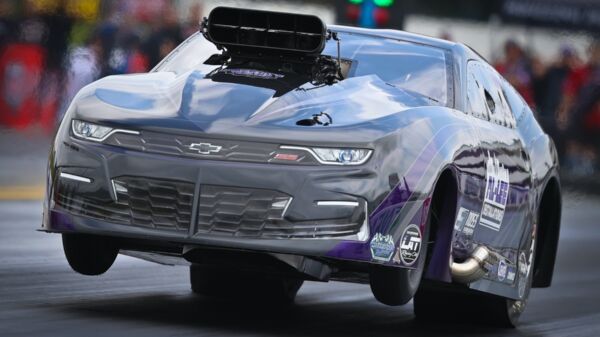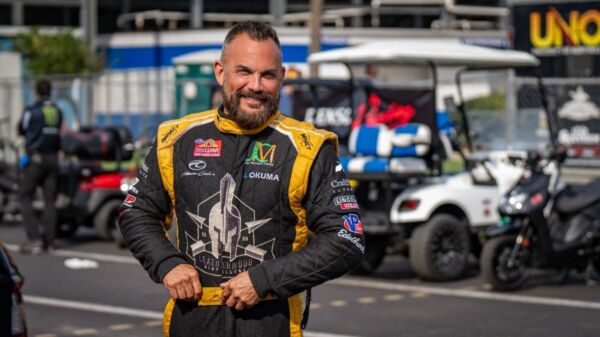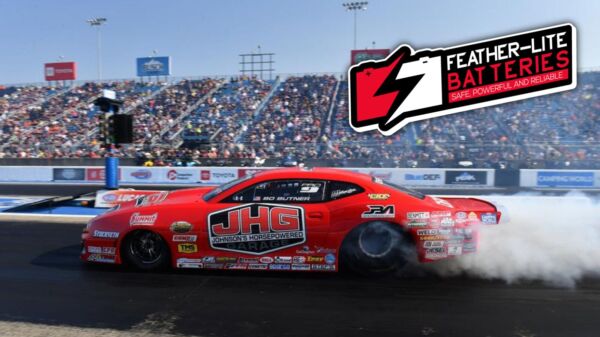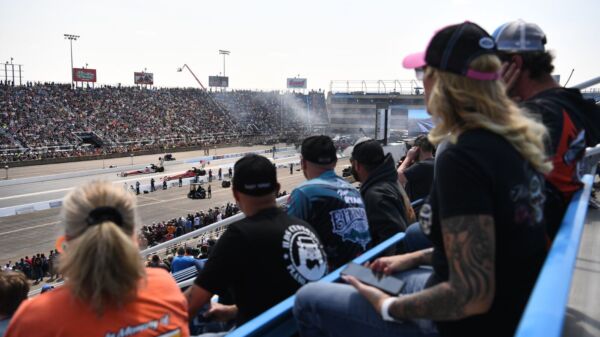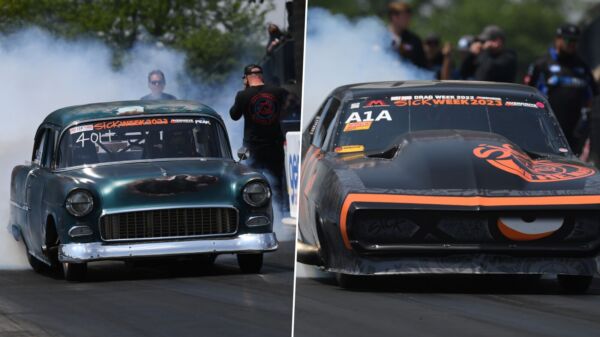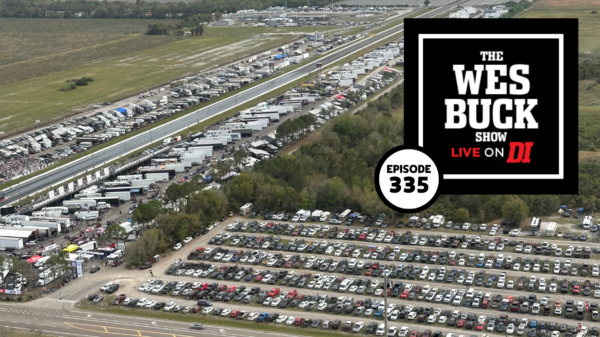When Jim Halsey stopped the clocks with a 3.592-second, 210.77 mph blast in qualifying at the 2020 Snowbird Nationals at Bradenton Motorsports Park last December, he further cemented his reputation as one of the most accomplished nitrous Pro Modified drivers of the 21st century. The performance made him the first nitrous-assisted big-tire Pro Mod driver to dip into the 3.50-second zone in the eighth mile. It was also the first time a nitrous car of any tire size went faster than 210 mph in the eighth mile.
Setting new performance marks for the entire nitrous combination is nothing new for Halsey, who became the first nitrous Pro Mod driver to run a 5-second quarter-mile pass during the 2008 Shakedown at E-Town at the now-defunct Old Bridge Township Raceway Park in Englishtown, New Jersey. He was also the first nitrous Pro Modified driver to go 240 mph in the quarter mile.
[Editor’s Note: This story originally appeared in DI #165, the Season Preview Issue, in February of 2021.]
“It’s cool. Numbers are numbers,” Halsey says of his most recent barrier-breaking performance. “I’m sure that sometime in the next year it’s going to get quicker and faster. But to be able to be the first to do it is pretty cool, especially after being the first to the 5s and now the first to the 3.50s.”
Halsey is right. Numbers are numbers, but there’s a story behind those numbers. For Halsey, it’s a story of redemption, of persistence, and of surrounding oneself with the best people to achieve a common goal.
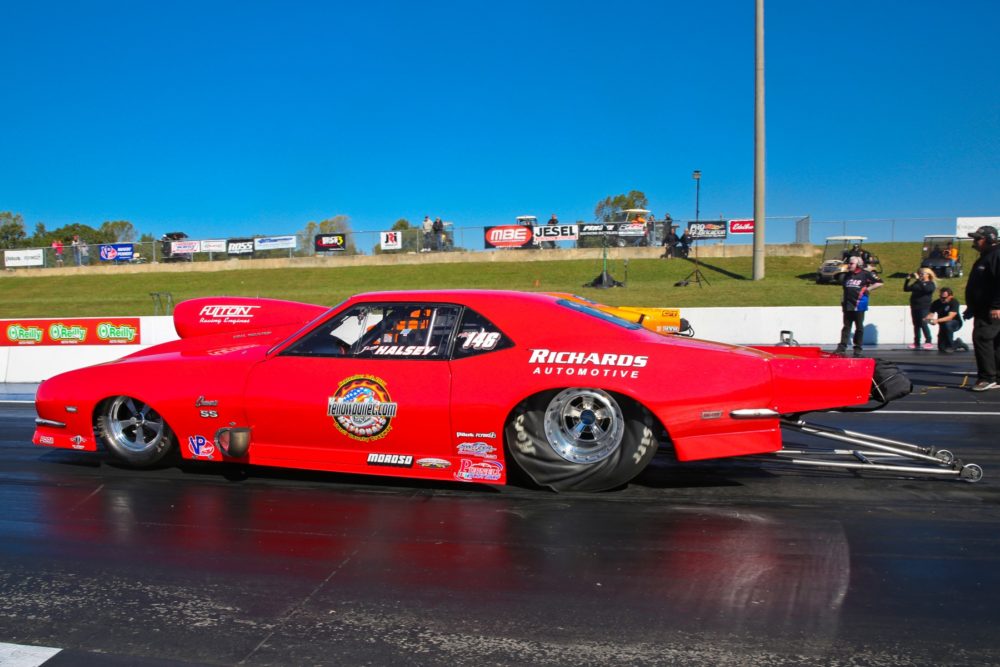
Tara Bowker photo
A little over three years after making nitrous racing history, Halsey lost nearly all of his racing equipment in a shop fire caused by a motorhome. The casualties included his truck, trailer and motorhome. His fire engine red, Gene Fulton-powered ’68 Camaro was burned up pretty badly in the blaze, but it wasn’t a complete loss.
“We took a little bit of time to regroup,” Halsey says. “Probably by design, I can’t remember the date of the fire, but I think the rest of the 2012 season, we pretty much sat out to get things back together. The Coleman’s Purnell Body Shop, they’re the ones that mounted the new body on the old car and painted it for us and got it back in tip-top shape. That was the last red car we had. I think we started back doing some testing and maybe some local races in 2013, but we really didn’t do anything for quite a while.”
Halsey continued staying close to home, going to races that weren’t much more than a few hours away from his shop in Havre de Grace, Maryland. He’d race at events at Cecil County Dragway, the facility he owns and operates with his girlfriend of over 30 years, Cathy Crouse. He’d hit up an ADRL race or two when the series came to the Northeast, then dabbled in PDRA events when the series was launched in 2014.
In 2016, Halsey decided it was time to step it up again. The Pro Nitrous class was rapidly progressing in a way that Halsey’s car couldn’t keep up with. It was at the top of the world in the late 2000s, but technology advancements over the past 10 years started to rule it out as a serious contender.
Halsey called on Brandon Switzer, who he knew as a standout young tuner when Halsey was racing IHRA Pro Modified and the early days of ADRL Pro Nitrous.
“We were at a point where we were kind of stuck where we were at and it was hard to make progression,” Halsey says. “These guys were starting to run faster than we could. And we were still running the clutch, not a torque converter. We were running carburetors and not fuel injection. I knew Brandon for a long time, and I knew he was sharp with fuel injection and stuff. It only made sense for me to call him up and get him involved.”
As Halsey remembers, Switzer started working on Halsey’s car at the 2016 PDRA Bradenton race. The race was plagued by weather issues and ended up getting rained out, but it still gave Halsey a chance to see what Switzer could do with his car.
“He took the car that I was racing at the time and probably the first weekend, picked it up close to a tenth. So it was a pretty quick turnaround,” Halsey says.
 Still, Halsey and Switzer felt the car was behind. He bought his current car, another ’68 Camaro, used from Jerry Bickel Race Cars. It was already set up for a torque converter, giving Halsey one more reason to make the switch over to a Neal Chance converter from a clutch.
Still, Halsey and Switzer felt the car was behind. He bought his current car, another ’68 Camaro, used from Jerry Bickel Race Cars. It was already set up for a torque converter, giving Halsey one more reason to make the switch over to a Neal Chance converter from a clutch.
One thing that didn’t change when Halsey put together the new car was the engine builder. Gene Fulton was one of, if not thego-to guy, for big nitrous engines when Halsey went into the 5s with his Fulton-built 800ci powerplant. But other engine builders had become more prominent by the mid-2010s. Regardless, Halsey stuck with Fulton, though he upgraded to a 959ci mill.
“I’ve been loyal to everyone,” Halsey says. “If it’s racing or work or whatever, as long as I feel that I’m getting the right product and treated fairly, I’m pretty loyal. We had run numbers prior to our stopping that were pretty close to the numbers that they were running when we came back. We knew that the engine program was fairly good.”
The 2017 season was a bit of a developmental year for Halsey as the team got accustomed to the new car and learned its nuances. It showed signs of promise, but it wasn’t a late-round player just yet.
“It took us a year to get everything sorted out,” Halsey says. “You pick at it. Instead of making aborted runs and swinging for the fence, you make small changes and you make small progression.”
Halsey came out swinging in 2018. He reached the final round at the third race on the PDRA tour, the Summer Drags at U.S. 131 Motorsports Park in Martin, Michigan. Another runner-up finish followed a few races later at the World Finals at Virginia Motorsports Park, where he set a new class E.T. record in the semifinals.
In just two seasons, Halsey had returned to a point where he could qualify in the top five, set records and win rounds. He was competing with the stars of Pro Nitrous, which at the time included Tommy Franklin, Jason Harris, Jay Cox and Lizzy Musi. The class was continuing to rapidly evolve, as drivers and engine builders like Pat Musi, Charlie Buck, and Fulton charged toward the 3.50s.
“I think we got to a competitive level with them,” Halsey says of the top Pro Nitrous drivers at the time. “I would say this: they motivated me. Hopefully I motivated them as well. So I think we all picked it up together trying to outrun each other.”

Tara Bowker photo
The record-setting performance at the World Finals was a preview of what was to come in 2019. Halsey went on a tear, winning the first two races of the season. He suffered early exits at the next two races, but picked back up with a runner-up and two more wins at the final three races of the PDRA season. He decisively earned his first-ever major national series championship, winning it by over six rounds’ worth of points.
“That’s pretty motivational,” Halsey says. “I’ve won track championships, like local series championships and stuff like that. But nothing ever big; nothing on the national level, anyway. One year (2009) in ADRL, I think we had a sizable lead and then lost in the semifinals in the Battle of the Belts, which I just had an off day that day. But nothing is more motivational than winning, that’s for sure.”
With his long-awaited and well-deserved first championship in hand, Halsey went into defense mode for the 2020 PDRA season. When the season finally started two months later than scheduled due to the COVID-19 pandemic, Halsey admittedly struggled.
“We were trying to test some stuff while we were actually racing the car, instead of testing it during testing only,” Halsey says. “We ran OK. I think we went to a final or two, but we just weren’t as good as we were in 2019 for the first half of the year or so.”
Halsey started to bounce back, ultimately picking up his first win of the season at the penultimate race on the abbreviated six-race schedule, DragWars at GALOT Motorsports Park. He went into the World Finals just one round behind Franklin.
The two drivers qualified on opposite sides of the ladder, meaning they wouldn’t face each other until the final round – if they both made it that far. Halsey earned 9 points more than Franklin did in qualifying, tightening up the championship battle.
Franklin’s Musi-powered “Jungle Rat” ’69 Camaro was a hundredth quicker than Halsey’s “Daddy Shark” ’68 Camaro in the first two rounds of eliminations. Franklin unexpectedly slowed to a 3.815 in a losing battle with Matt Guenther in the semifinals, while Halsey picked up in a big way with his 3.645-second victory over 2020 Mid-West Drag Racing Series Pro Mod champion Ron Muenks. It was all Halsey needed to claim the 2020 world championship – by just 9 points – in a dramatic, come-from-behind triumph. The final round wasn’t contested, as rain and fog prevented the completion of the event.
The second consecutive championship was a meaningful victory for Halsey, but in the process he also accomplished a major feat for Fulton Competition Engines, which he’s proudly continued to support. By qualifying No. 1 at four of the six PDRA races, Halsey handily clinched the 2020 Nitrous Wars engine builders championship for Fulton.
“It’s cool. Gene’s been around forever,” Halsey says. “I’ve been a customer of his for close to 20 years, if not right at 20 years. A lot of people had him written off. I guess we’re showing the old man’s still got it.”
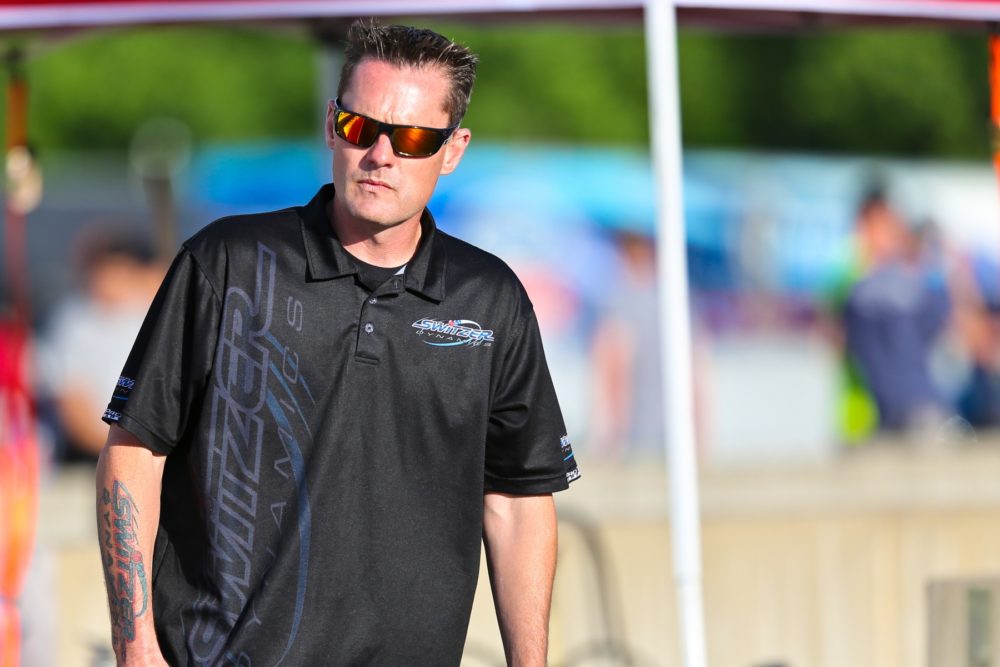
Tara Bowker photo
Brandon Switzer’s fascination with nitrous oxide, and specifically its use as a power adder in drag racing, started when he was in high school. He was working at Steeda Autosports, an aftermarket manufacturer of Ford performance parts, and he started to believe there was tons of room for improvement in the nitrous world.
“Everybody had Vortechs or turbos or whatever, but then there was a couple of guys that had nitrous,” Switzer says, pointing out that this was around 30 years ago. “I was seeing everybody put nitrous on their engines and tear stuff up. Nitrous got a bad rap. I guess I became interested in working on the problem.”
Switzer’s interest in solving problems was a trait he picked up from his father, who solved problems in the medical industry doing R&D work on blood cell analyzers.
“Everything I learned, I learned from my parents,” Switzer says. “My mom taught me discipline and my dad taught me probably the most important thing, which was how to solve problems systematically and how to evaluate a system and its complexity and variables.”
After high school, Switzer used the money his parents had set aside for college to launch his own performance shop, where he worked on a wide variety of projects. Around two years into the venture he started to specialize in nitrous systems and intake manifolds, which led to some collaborative work with Wilson Manifolds. He then sold some of his equipment to Wilson and went to work at the company.
In addition to building his business, Switzer raced competitively in the NMRA and Fun Ford series in a line of nitrous-fed Fords. He tuned his own car and was eventually called on to tune cars for Wilson’s customers. Towards the end of his five years at Wilson Manifolds, he was being flown to races to work with Pro Mod drivers Mike Castellana and Shannon Jenkins on their nitrous programs. That led to the formation of Speedtech Nitrous, which Switzer operated with Castellana and Jenkins until late 2011.
Switzer branched out and launched Switzer Dynamics in the spring of 2012. Located in Denver, North Carolina, a small town on the west side of Lake Norman, Switzer Dynamics is Switzer’s vision realized. With cutting-edge machines from DMG Mori and Haas Automation filling up 10,000 square feet of the 15,000-square-foot shop, it was a significant task to get it going.
“It was a big financial undertaking and a lot of stress to open a shop of this size with the limited amount of money that I had and the amount I had to borrow,” Switzer admits. “So that was stressful. It wasn’t necessarily challenging. I didn’t really have to overcome a lot of obstacles to make all of that happen. By the time I opened this place, I already had 20 years’ experience of running this kind of business, so the technical side of the business wasn’t really the hard part.”
The company has maintained consistent growth over the last nine years, even with Switzer spending the better part of 15-20 weekends a year at tracks around the country working with tuning customers. He’s able to get away from the shop mainly because of the small, tight-knit group of employees he has manning the machines and assembling products.
“I couldn’t be at the racetrack or doing the outside-of-the-shop activities if I didn’t have the best possible group of people here supporting me,” Switzer says. “I’ve put the right people that are very good by their own in place here and I spent a lot of time training them.”
Switzer is joined by his wife, Melissa, who works at the shop and travels to nearly all of the races with Brandon. The rest of the Switzer Dynamics team is made up of just three other people: Dan Carver, who handles sales, tech and installations; Darrell Lail, the manual machinist, welder and fabricator; and Hunter Devers, a machinist.

Along with his wife, Melissa, Brandon Switzer’s team includes (from left to right) Dan Carver, Darrell Lail, and Hunter Devers. (Rick Belden photo)
“Most people would be surprised at the amount of equipment, the level of what we do, and the amount of work that we do with the amount of people that we have,” Switzer says. “Most shops half our size have four times the number of employees. Instead of having five guys running one machine, we might have five machines that are set up correctly and one guy running them.”
The company’s fleet of CNC and fabrication-type machines includes several welders, press brakes, sheet metal working equipment, flow benches and digitizing equipment. It’s an impressive operation capable of making almost everything the company needs to build its products. The shop’s capabilities are perhaps best demonstrated by one of Switzer’s six-system Pro Mod billet intake manifolds.
“There’s 1,500 parts on that manifold when it’s complete,” Switzer says, “and the only thing we purchase to go on that manifold is the fasteners. We manufacture everything else on them here.”
On top of manufacturing the pieces for its manifolds and nitrous, Switzer Dynamics machines a number of other standalone components like valve covers. They also produce engine parts for engine builders, with additional customers outside the drag racing niche.
“I have some medical and military contracts that we sift through and we take on a few of those a year,” Switzer says. “We’ve done some big microscope projects. We’ve done some big naval projects. We do a lot of stuff other than just racing.”
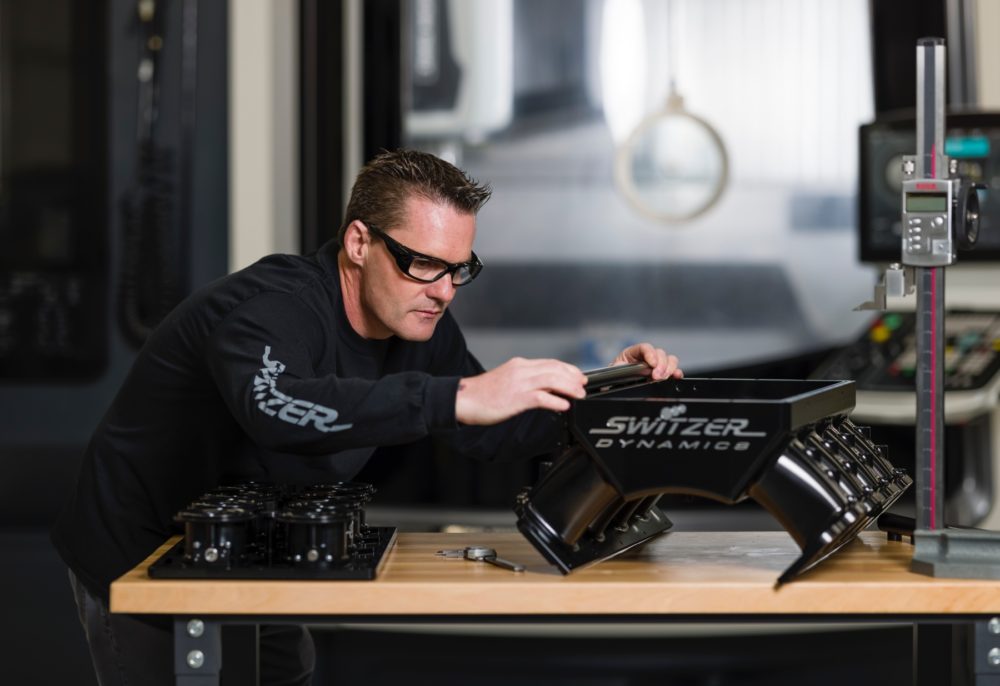
Rick Belden photo
Away from the shop, Switzer is involved in tuning no less than eight cars across different classes and sanctioning bodies. His customers include Halsey and Chris Rini in PDRA Pro Nitrous, Outlaw 10.5 star Mo Hall, Mid-West Drag Racing Series Pro Mod drivers Keith Haney and Jim Sackuvich, and Mike Achenbach, who’s dabbled in multiple eighth-mile Pro Mod organizations. He also works with John Benoit and Erica Coleman in the Top Sportsman ranks.
It might seem like a challenge to keep them all separate, but Switzer has managed to do just that.
“I approach every program individually with a lot of respect for the people involved in that program, the relationships that program has, and I treat them all individually and don’t try to combine them all and make them all the same,” Switzer says.
Even at a PDRA race, where Switzer might have a hand in two or three Pro Nitrous cars, he’s able to focus on each situation individually. He makes a point to provide the same service to every customer.
“When I’m at one trailer working on one program, my goal is for that car to win the next round,” says Switzer, who’s supported the Pro Nitrous class as its title sponsor since its ADRL days. “It is not ‘Who does that car run?’ I don’t ever look at who the car is running. The car is running whoever’s in the other lane. Ninety-nine percent of the time I find out that two of my customers are running each other after I’m done with my work.”
Through his years in the business, Switzer has been a major part of some of the biggest moments in nitrous racing’s recent history. His personal highlights out of those moments include Khalid alBalooshi piloting the first nitrous car to go 200 mph in the eighth mile at the ADRL Northeast Drags at Maple Grove in 2011, Pat Stoken recording the first 3.60-second eighth-mile pass (3.694) for a nitrous car at the 2015 PDRA Summer Drags at Martin, and finally, Halsey’s barrier-breaking 3.592 at 210.77 at Bradenton last year.
“The ones that stand out the most to me, the ones that we probably have the most pride in, were achieved by working towards a goal for a long period of time,” Switzer says. “And these instances had other people involved in them that were remarkable to deal with, just great people.”

Michael McMillan, Cathy Crouse, Jim Halsey and Eric Davis (Rick Belden photo)
There’s a quiet confidence that exists in Halsey’s pit area. Compared to neighboring pit areas, it’s almost too quiet. A newcomer might mistake it as awkward or uneasy, but it’s quite the opposite. “They’ve been with me forever,” Halsey says of his crew. His longtime friend and crew chief, Eric Davis, has been with the team since Halsey’s earliest days in Pro Modified, and Michael McMillan has similarly put in his time.
This collective experience allows the group to go about their work without much discussion. The men and women under this awning know exactly what they’re doing, so there’s no need to talk about it or openly ponder what might happen during the next round.
“In our pits, none of us talk at all,” Switzer says. “And it’s almost become, I wouldn’t say like a superstition, but we just don’t talk about numbers or what it’s going to run or anything. Everybody is expected to do their job and everybody counts on the next person doing their job. And it works really, really well.”
That’s not to say it’s not a fun team to be around. The whole group gets along well and enjoys a nice meal and a couple cold drinks together at the end of the night when racing is done for the day. But from the time they get to the track in the morning until the car is ready to be buttoned up for the night, it’s all business.
“When we race together, it’s just like you walked into work,” Switzer says. “It’s just like me walking into my shop with my guys here. You don’t need to tell them, they all know what to do. They make the right decision. There’s never a guess of ‘How would this guy do this?’ or ‘What would he think?’ or whatever. Anyone here knows because there’s one correct way of doing it or handling it.”
A lot of the team’s success over the last few years can be attributed to this business-like mindset. Everyone involved is laser-focused on being better than they were the last round, or better yet, better than the guy in the other lane in the next round. In several occasions, the result has been a new E.T. or speed record or another winner’s circle photo to hang on the shop wall.
“A lot of people race to have fun,” Switzer begins. “Well, our position on that is losing isn’t fun. So the only way we’re going to have any fun is to win. Racing isn’t fun. Losing sucks. Winning is fun for five minutes. Those big things last five minutes, then it’s out of your mind. And the next thing is, ‘OK, who’s going to kick our ass next? What do we have to do to be better?’ You can’t get complacent.”
This dynamic works so well because Halsey and Switzer are on the same page. Nitrous racing at the sport’s highest levels is Switzer’s business, and while it isn’t technically Halsey’s business, it becomes his business when he gets to the track. He’s there to beat the best and to be the best, an M.O. that perfectly aligns with Switzer’s mindset when it comes to business.
“Jimmy runs his race team and holds himself to the same standards I do in my business,” Switzer says. “It is unbelievably important to me that we are the best at what we do, that we hold the records, that we do all these things, and we will do whatever we have to do to crush our competition in business.”
“We both have the same work ethic,” Halsey adds. “Daylight to dark, seven days a week, we always try and improve our program, whether it be race cars or pouring concrete or whatever.”

Tara Bowker photo
The qualities that have made Halsey and Switzer successful in their respective businesses play into the race program, especially when it comes to acting decisively and independently as leaders.
“Jimmy and I are very, very, very much the same,” Switzer says. “So you would think it would be a conflict, but it doesn’t because it’s not that kind of relationship. We’re both leaders. We both make decisions. We don’t want to follow anything else. But he’s doing one side of things, I’m doing another side.”
Switzer is able to hone in on tuning the car without having to worry about Halsey throwing it all away with a bad light, while Halsey can focus on doing his part to make the perfect run with the utmost confidence in the car making it to the finish line under power.
“Not one time has he ever gone up to the starting line and I say, ‘Jimmy, man, you really got to be on the tree.’ It’s expected,” Switzer asserts. “I expect that from him. And he expects the car to run the best car can possibly run.”
This mutual understanding benefits Switzer in more ways than one. He’s able to make tuning calls without outside influence, plus he knows Halsey will pilot the car with a precise driving style that only years of experience can produce.
“Flat out, Jim is just a badass driver, period,” Switzer says. “He is mechanical. He doesn’t have opinions. Ninety-nine percent of the time, he doesn’t ask me a single question, not from day one has he ever. He goes up to the starting line having no idea what’s going to happen, never even asks. And that affects somebody in my shoes a certain way.”
It continues after the run, as Halsey can provide feedback that even the best data loggers can’t offer.
“We think a lot alike,” Halsey says. “We talk the same language. After a run, I can tell him what I think the car felt like. And it usually is about the same as what he’s thinking it should have done. We’ve both been doing it for a long time. We both have the same lingo, I guess you could say.”

Chris Sears photo
After breaking what could be considered two of the last remaining major barriers in nitrous Pro Mod racing, at least for the time being, they’re left to look ahead at the next chunk of numbers that need to be recorded before the 3.40-second, 220-mph barriers that loom in the distance can be knocked down.
It seems a little realistic, especially since it’s still somewhat surreal that the last barriers were broken.
“When we went .60s, I said I wouldn’t be around to go .50s,” Switzer says. “I said the same thing when we went .50s. I’m like, ‘Well, that was it.’ There’s no way when we went a .69 that I thought I’d be around to go over 210. It wasn’t even that much longer from the .69 that we went .59 and 210. As soon as we went the .59, I said, ‘That’s the last one I’ll be around for.’ And everyone’s like, ‘That’s what you said last time.’”
Still, Switzer doesn’t rule out the possibility of a nitrous car dipping into the 3.40s or reaching 220 mph in an eighth of a mile. He can’t accurately predict the timeline, as there are way too many variables at play, but he does believe it’s something the class will be chasing for quite some time.
“It’s an exponentially difficult thing to try to reach those goals because what it takes to go from 4.00 to 3.90 is not even comparable to what it takes to go from 3.59 to 3.49,” Switzer points out. “I don’t know if a lot of people understand what it would take to go from a .59 to a .49. It’s monumental. I’m not saying it couldn’t be done, but it isn’t going to be done in a couple of years. I can guarantee you that.”
Halsey is similarly bearish when it comes to the possibility of a run in the 3.40s. “I think 3.40s is probably going to be out of my reach, career-wise. But you never know.”
When it comes to his future in racing, Halsey remains focused on eighth-mile competition, specifically in PDRA Pro Nitrous. He doesn’t really have any interest in quarter-mile NHRA Pro Mod competition. That game has changed a ton since he won the 50th annual NHRA U.S. Nationals in 2004, when 29 drivers attempted to qualify for the eight-car field.
It’s not the technical differences between his current eighth-mile Pro Nitrous setup and a quarter-mile NHRA Pro Mod combo that rules out the move. Nor is it the fact that he would be one of just a couple nitrous cars competing against a field of supercharged and turbocharged cars.
The scheduling differences are the main factor for Halsey. The PDRA’s eight stops are all within an eight-hour drive of Halsey’s Maryland home, while the NHRA Pro Mod schedule stretches to 12 races as far south as Gainesville, Florida, and as far west as Las Vegas. The NHRA’s event schedule begins with parking on Wednesday or Thursday and doesn’t conclude until Sunday afternoon, pushing post-race travel well into Monday. On the contrary, Halsey can win a PDRA race late Saturday night and be home in time for Sunday supper.
“We have several businesses we run and it’d be hard for me to take the time off to chase the NHRA stuff,” Halsey says. “Is it out of possibilities? No, never.”
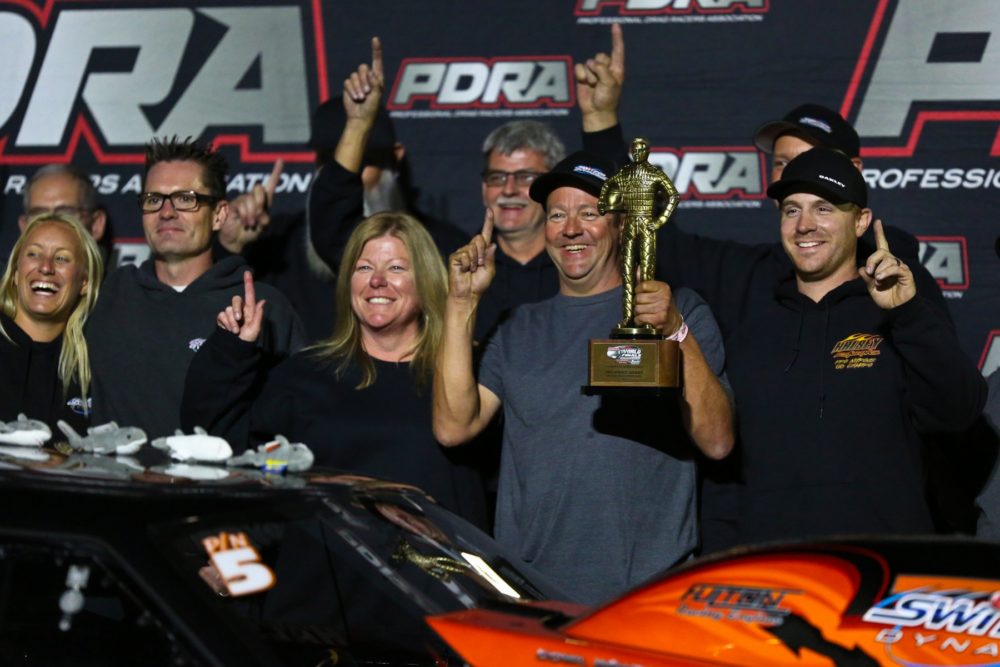
Tara Bowker photo
So PDRA Pro Nitrous will be stuck with Halsey for the foreseeable future. But that’s a good thing for the class, and even Halsey’s biggest rival, Tommy Franklin, recognizes that. Even though he lost the 2020 world championship to Halsey in eliminations at the World Finals after leading points for most of the season, Franklin is a firm believer in the age-old notion that to be the best, you have to beat the best.
“To lose that [championship] sucks, but I love racing at that level and I love the competition side of it,” Franklin says. “It’s bitter to walk away and be on the losing side, but that keeps you driving and pushing towards [winning]. I wouldn’t have it any other way.”
Franklin isn’t afraid to admit Halsey and his team are the best in the class going into the PDRA’s eighth season. Halsey’s performance over the last two seasons has put a massive target on his back, and Franklin is leading a pack of Pro Nitrous hitters who will attempt to prevent a three-peat.
“That whole team, front to back, is top notch right now and they’re the ones we have our sights on,” Franklin says. “Jim Halsey is somebody who’s proved himself in prior years, got off a little bit and came back when he was ready and boy, he came back with a vengeance.
“He’s doing good,” Franklin continues, “but I can also say I don’t feel like he’s unbeatable and I do feel like we’re going to do everything we can to beat him. That’s the goal of this stuff. If I was showing up without the idea that I want to be better than him, then I probably don’t need to show up. The truth is we’re going to work hard and do everything we can to dethrone him – take the teeth out of the shark.”
With the knowledge that the target on their backs is larger than ever, Halsey will continue working towards a third consecutive title. It would give him the most championships of any driver in PDRA Pro Nitrous history, as he’s currently tied with Franklin (2016-2017) and Jason Harris (2014 and 2018) with two apiece.
But Halsey won’t stop there. He’s showing no signs of slowing down in this second wind of his career.
“I’d like to win a few more championships before I hang it up,” he says. “As long as I’m healthy and can do my job driving and enjoy doing what I’m doing, I’ll be here for a long time.”
This story was originally published on April 7, 2021. 
